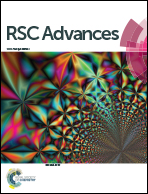In vitro model reaction of sulfur containing bio-relevant ligands with Pt(ii) complex: kinetics, mechanism, bioactivity and computational studies†
Abstract
cis-[Pt(MAMP)Cl2] 1 and its hydrolysed product cis-[Pt(MAMP)(H2O)2]2+ 2 (where MAMP = 2-[(N-methylamino)methyl]pyridine) were synthesised and characterised by spectroscopic methods. Kinetic and mechanistic studies were followed on complex 2 with thiols; L-cysteine (L-cys) and N-acetyl-L-cysteine (N-ac-L-cys). The thiol substituted products [Pt(MAMP)(L-cys)] 3 and [Pt(MAMP)(N-ac-L-cys)] 4 formation mechanisms were proposed and characterized. Their bonding modes were also confirmed spectroscopically and theoretically. At pH 4.0, the interactions of complex 2 with the ligands show two distinct consecutive steps: the first step is dependent and the second is independent of [ligand]. The association equilibrium constant (KE) for the outer sphere complex formation and rate constants for both steps have been evaluated. The activation parameters (ΔH‡ and ΔS‡) for both the steps were calculated using the Eyring equation and an associative mechanism is proposed for both the reactions. Structural optimization, HOMO–LUMO energy calculation, and Natural Bond Orbital (NBO) analysis of complexes 2–4 were investigated with Density Functional Theory (DFT). The complexes bind strongly to DNA and change its electrophoretic mobilization pattern in agarose gel. For theoretical understanding of the binding interaction of complex 2 with B-DNA, a molecular docking study was performed. Anticancer properties of all the three complexes 2–4 were probed on both HeLa and Hep G2 cell lines which shows remarkable activity of 70–75% compared to cisplatin at 50.0 μM concentration. Significant growth inhibition by the complexes in both Gram positive and Gram negative bacteria was observed. The water soluble complexes 2–4 may be further investigated and might be considered as chemotherapeutic agents.


 Please wait while we load your content...
Please wait while we load your content...